Europe
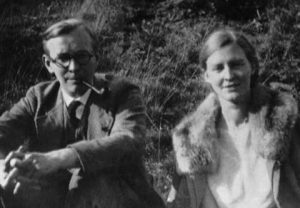 Mildred Fish was an American-German literary historian, translator, and later, a German Resistance fighter in Nazi Germany. They fell in love and married, moving to Germany right after. She met her future husband, Arvid Harnack in 1926. Arvid was a grad student at the University of Wisconsin-Milwaukee, and a Rockefeller Fellow from Germany. In Germany, Mildred worked in education and Arvid secured a position with the Reich Economic Ministry. Throughout the 1930s, Mildred and Arvid, became increasingly alarmed by Hitler’s rise to power. They could see that he had ulterior
Mildred Fish was an American-German literary historian, translator, and later, a German Resistance fighter in Nazi Germany. They fell in love and married, moving to Germany right after. She met her future husband, Arvid Harnack in 1926. Arvid was a grad student at the University of Wisconsin-Milwaukee, and a Rockefeller Fellow from Germany. In Germany, Mildred worked in education and Arvid secured a position with the Reich Economic Ministry. Throughout the 1930s, Mildred and Arvid, became increasingly alarmed by Hitler’s rise to power. They could see that he had ulterior 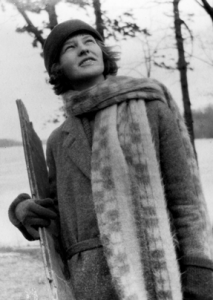 motives. They communicated with a close circle of associates who believed communism and the Soviet Union might be the only possible stumbling block to complete Nazi tyranny in Europe.
motives. They communicated with a close circle of associates who believed communism and the Soviet Union might be the only possible stumbling block to complete Nazi tyranny in Europe.
When Mildred came to the United States for a lecture tour in 1937, her family begged her to relocate permanently, but she refused and resumed her life in Germany. I suppose she thought she could be of better assistance there than in the United States. When war was declared in 1941, she did not leave with other Americans.  They couldn’t leave, because by then, Mildred and Arvid were involved with a communist espionage network known by the Gestapo as “The Red Orchestra”. The ring, which provided important intelligence to the USSR, was compromised and the members were arrested. I’m sure they knew this was a death sentence for them.
They couldn’t leave, because by then, Mildred and Arvid were involved with a communist espionage network known by the Gestapo as “The Red Orchestra”. The ring, which provided important intelligence to the USSR, was compromised and the members were arrested. I’m sure they knew this was a death sentence for them.
After they were tried as traitors, Arvid was sentenced to death and executed on December 22, 1942. Mildred was given a six year sentence, but Hitler refused to endorse her punishment. As only a dictator can, he insisted on a retrial, after which she was condemned on January 16, 1943. She was beheaded by guillotine at Plotzensee Prison on February 16, 1943. She was the only American female executed on the orders of Adolf Hitler. Because of her connection to possible communist sympathies and post-war McCarthyism, her story is virtually unknown in the United States.
 Whether it was World War I or World War II, every flyer knew what a dogfight was. Dogfights were the undisputed, most intense type of aerial combat there was. Basically it was an intense game of chicken…one that no one really wanted to play. The fight for supremacy in the skies over Europe was vital to the war effort. The Axis of Evil nations had to be stopped, and the air war was going to be the way to win the war.
Whether it was World War I or World War II, every flyer knew what a dogfight was. Dogfights were the undisputed, most intense type of aerial combat there was. Basically it was an intense game of chicken…one that no one really wanted to play. The fight for supremacy in the skies over Europe was vital to the war effort. The Axis of Evil nations had to be stopped, and the air war was going to be the way to win the war.

After watching some of the cockpit footage of the dogfights, I don’t know how those pilots did it. In the non-war world, two planes going head to head is not an ideal situation, but that was what the fighter planes of war have to do. As one plane starts to gain dominance over another, the plane being chased often goes into a steep climb, followed by the pursuing plane. The first plane to stall is going to end up being chased, because as he loses power, he drops and then must run first to gain power and then to get away from his attacker. If you thought going head to head with another plane was scary, imagine a deliberate stall…for supremacy!! That just seems insane to me, but that is 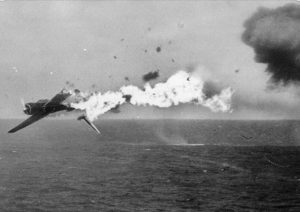 the nature of the dogfight. These pilots had to be very brave. There is no way to fly like that, or especially fight like that unless you area very brave pilot…not to mention a skilled pilot. Without that skill, the pilots would not survive long enough to even become an ace.
the nature of the dogfight. These pilots had to be very brave. There is no way to fly like that, or especially fight like that unless you area very brave pilot…not to mention a skilled pilot. Without that skill, the pilots would not survive long enough to even become an ace.
For a fighter pilot to become an ace, he had to shoot down five enemy planes. A gunner could become an ace too, but the majority of aces are fighter pilots. The key to becoming an ace, besides shooting down the enemy, is obviously to stay alive long enough to become an ace. In these dogfights, that was difficult for sure.

 It seems like these days, the more unique a motorcycle is, the more attention it gets. I don’t think anyone who as seen an unusual motorcycle, can say that they weren’t impressed, amused, or just shocked. You can’t really believe what you are seeing, but it’s hard to look away too. I sometimes wonder how these people came up with such an idea. I guess it takes a great deal of imagination. Some of these designs, are hilarious, and there is seriously no other word for it. People just think of something that is important in their lives, and turn their motorcycle into so version of that thing.
It seems like these days, the more unique a motorcycle is, the more attention it gets. I don’t think anyone who as seen an unusual motorcycle, can say that they weren’t impressed, amused, or just shocked. You can’t really believe what you are seeing, but it’s hard to look away too. I sometimes wonder how these people came up with such an idea. I guess it takes a great deal of imagination. Some of these designs, are hilarious, and there is seriously no other word for it. People just think of something that is important in their lives, and turn their motorcycle into so version of that thing.
While strange bicycles, and even motorcycles, seem like a hilariously funny idea, that might land you on the 
 ground sometimes, some strange looking motorcycles would seem to me like something a little riskier…especially if you get some speed behind it. Such is the case with the monocycle. I’m not a big fan of motorcycles anyway, so to modify one just to make it a novelty seems an odd idea, indeed. Still, as long as the safety of the motorcycle doesn’t enter into the picture, I guess it’s ok, but some people really got carried away. There were a few monocycles that people rode, and for me, that seems like a dangerous thing to ride. Motorcycles are hard enough upright with two wheels, but to remove one wheel and ride that contraption on the
ground sometimes, some strange looking motorcycles would seem to me like something a little riskier…especially if you get some speed behind it. Such is the case with the monocycle. I’m not a big fan of motorcycles anyway, so to modify one just to make it a novelty seems an odd idea, indeed. Still, as long as the safety of the motorcycle doesn’t enter into the picture, I guess it’s ok, but some people really got carried away. There were a few monocycles that people rode, and for me, that seems like a dangerous thing to ride. Motorcycles are hard enough upright with two wheels, but to remove one wheel and ride that contraption on the 
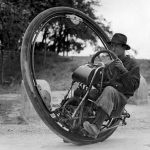 remaining wheel…just crazy!!
remaining wheel…just crazy!!
Nevertheless, that is what Messrs Cislaghi and Goventosa of Italy did, when they built the Motoruota in the 1920s. While it looked so unusual that is was sure to attract attention, it really was a dangerous motorcycle. Apparently the design was popular in Europe, especially France and Italy. They were interesting, to say the least, and I’m sure everyone would want to see it, but you would never get me on one of these contraptions. I value my life much more than that.
 After World War II, most of Europe was in a big mess, whether it was the land,the cities and towns, or the government. There were scores of dead people around, countries and borders were torn apart, most of Europe had been “ground into a very civilized kind of pudding…and the USSR was knocking on the door to come and raid the fridge…so to speak.” Russia would have loved to sneak in and take over when they were at their most vulnerable. The people looked to the United States to figure out away to keep them safe, but not to occupy their countries, per se. That is a rather tall order, but one that the United States took seriously.
After World War II, most of Europe was in a big mess, whether it was the land,the cities and towns, or the government. There were scores of dead people around, countries and borders were torn apart, most of Europe had been “ground into a very civilized kind of pudding…and the USSR was knocking on the door to come and raid the fridge…so to speak.” Russia would have loved to sneak in and take over when they were at their most vulnerable. The people looked to the United States to figure out away to keep them safe, but not to occupy their countries, per se. That is a rather tall order, but one that the United States took seriously.
So the United States came up with Operation Gladio. Basically, they installed a secret military that would unofficially operate all across Europe. The secret military would have one and only one goal…combating communism. Little is known about this secret military, even today, because it wouldn’t be a very good secret army if we knew all about them. So, facts are pretty limited, but it’s not some crazy theory either. Their existence has been confirmed, and the network has been associated with such high-stakes super-evil events, as an attempted pope assassination, large scale bombings, and kidnappings of several high-level government officials. They were willing to do anything to fight communism…murder, extortion, even seemingly becoming communists, if that’s what it took. It turns out that the Italian branch was a particularly active group. An entirely different president of Italy, Francesco Cossiga, was involved in this ominous anti-communism secret society. The reason we don’t know more about them, even years after the end of the Cold War, is simple: crazy, crazy murders. Their secrets will follow them to the grave.
Then a new Italian president was elected. President Aldo Moro, wanted to allow communists to run for office.The still operating Gladio could not let this happen. He was suddenly kidnapped and eventually executed.  His body was found in the trunk of a car parked next to an ancient gladiatorial site. A warning to others…more than probably!! A “gladio” is an ancient Roman short sword, used in arena combat. A former colonel of Gladio operations in Switzerland decided to write a letter to the government stating that he was ready to “reveal the whole truth.” Again, Operation Gladio took action. The Gladio colonel was found dead in his home a month later. He was stabbed to death with his own bayonet. There were a series of mysterious characters written on his chest that couldn’t be deciphered. Of course, that’s not concrete evidence of Gladio’s direct involvement in these events, but these are just two brutal, worrying events that spin a web of mystery and fear that keeps further investigations from being opened. Sometimes, it’s best to let sleeping dogs lie.
His body was found in the trunk of a car parked next to an ancient gladiatorial site. A warning to others…more than probably!! A “gladio” is an ancient Roman short sword, used in arena combat. A former colonel of Gladio operations in Switzerland decided to write a letter to the government stating that he was ready to “reveal the whole truth.” Again, Operation Gladio took action. The Gladio colonel was found dead in his home a month later. He was stabbed to death with his own bayonet. There were a series of mysterious characters written on his chest that couldn’t be deciphered. Of course, that’s not concrete evidence of Gladio’s direct involvement in these events, but these are just two brutal, worrying events that spin a web of mystery and fear that keeps further investigations from being opened. Sometimes, it’s best to let sleeping dogs lie.
 Most often, when we think of the early Americans, and their settlements, we think about the settlers who came over from Europe, but there were, of course, the many Indian tribes that existed here first. I’m not going to dispute whether the Indians or the White Man have more right to be here, because I truly believe that we should all be able to co-exist here after all these years, and that while treaties were broken many times, we have more than likely paid for this land a number of times, given the money that has been, and continues to be paid to the Native Americans. The oldest known culture in the United States was the Pueblo Indians, who lived in the Southwestern United States. Their name is Spanish for “stone masonry village dweller.” They are believed to be the descendants of three major cultures…the Mogollon, Hohokam, and Ancient Puebloans (Anasazi) Indians. I’m not sure how they would have come to be here, unless their ancestors were here first, but that is how the historians see it.
Most often, when we think of the early Americans, and their settlements, we think about the settlers who came over from Europe, but there were, of course, the many Indian tribes that existed here first. I’m not going to dispute whether the Indians or the White Man have more right to be here, because I truly believe that we should all be able to co-exist here after all these years, and that while treaties were broken many times, we have more than likely paid for this land a number of times, given the money that has been, and continues to be paid to the Native Americans. The oldest known culture in the United States was the Pueblo Indians, who lived in the Southwestern United States. Their name is Spanish for “stone masonry village dweller.” They are believed to be the descendants of three major cultures…the Mogollon, Hohokam, and Ancient Puebloans (Anasazi) Indians. I’m not sure how they would have come to be here, unless their ancestors were here first, but that is how the historians see it.
Over the years, the Ancient Puebloans, who had been a nomadic, hunter-gathering society, evolved into a sedentary culture. They made their homes in the Four Corners region of Colorado, New Mexico, Utah and Arizona. The Puebloans continued to hunt, but they also expanded to agriculture. They grew maze, corn, squash, and beans. They also raised turkeys and even developed a fairly complex irrigation system. They took up basket weaving and pottery, and became quite skilled in both. About this time, they began building the  buildings we think about when we think of the Pueblo Indians…villages, often on top of high mesas or in hollowed-out natural caves at the base of canyons. These multiple-room dwellings and apartment like complexes, designed with stone or adobe masonry, were the forerunner of the later pueblos.
buildings we think about when we think of the Pueblo Indians…villages, often on top of high mesas or in hollowed-out natural caves at the base of canyons. These multiple-room dwellings and apartment like complexes, designed with stone or adobe masonry, were the forerunner of the later pueblos.
Sadly, even with their successful life changes, the Ancient Puebloans way of life declined in the 1300’s, probably due to drought and inter-tribal warfare. They migrated south, primarily into New Mexico and Arizona, becoming what is today known as the Pueblo people. For hundreds of years, these Pueblo descendants lived a similar lifestyle to their ancestors. They continued to survive by hunting and farming, and also building “new” apartment-like structures, sometimes several stories high. These new structures were made of cut sandstone faced with adobe, which is a combination of earth mixed with straw and water. Sometimes, the adobe was poured into forms or made into sun-dried bricks to build walls that are often several feet thick. The buildings had flat roofs, which served as working or resting places, as well as observation points to watch for approaching enemies and view ceremonial occasions. For better defense, the outer walls generally had no doors or windows, but instead, window openings in the roofs, with ladders leading into the interior.
 Each family unit consisted of a single room of the building unless the family grew too large. Then side-rooms were sometimes added. The houses of the pueblo were usually built around a central, open space or plaza in the middle of which was a “kiva,” a sunken chamber used for religious purposes. Each pueblo was an independent and separate community. The different pueblos shared similarities in language and customs, but each pueblo had its own chief, and sometimes two chiefs, a summer and winter chief, who alternated. Most important affairs, such was war, hunting, religion, and agriculture, however, were governed by priesthoods or secret societies. Each pueblo was almost a separate country.
Each family unit consisted of a single room of the building unless the family grew too large. Then side-rooms were sometimes added. The houses of the pueblo were usually built around a central, open space or plaza in the middle of which was a “kiva,” a sunken chamber used for religious purposes. Each pueblo was an independent and separate community. The different pueblos shared similarities in language and customs, but each pueblo had its own chief, and sometimes two chiefs, a summer and winter chief, who alternated. Most important affairs, such was war, hunting, religion, and agriculture, however, were governed by priesthoods or secret societies. Each pueblo was almost a separate country.

 My grandnephew, James Renville is one of the nicest, kindest, most thoughtful young men that people could ever know. This is information that comes to me from the people who know him the best, and not just one of them, but rather all of them. James is a family man who dearly loves his family. For James, family comes first, and he always puts them first, even if he has to change his own plans. He is soft spoken, and thinks before he speaks, making sure that his words do not hurt others. James always thinks the best of people, even if others don’t necessarily see good in them. James looks in their heart.
My grandnephew, James Renville is one of the nicest, kindest, most thoughtful young men that people could ever know. This is information that comes to me from the people who know him the best, and not just one of them, but rather all of them. James is a family man who dearly loves his family. For James, family comes first, and he always puts them first, even if he has to change his own plans. He is soft spoken, and thinks before he speaks, making sure that his words do not hurt others. James always thinks the best of people, even if others don’t necessarily see good in them. James looks in their heart.
As a little boy, James was very into the Ninja Turtles, and he went through a Mortal Kombat phase. For several Christmases, all he wanted for Christmas was the costumes for Mortal Kombat and Ninja Turtles. Thankfully, my sister, Cheryl Masterson, who is James’ grandmother, had the talent to make those costumes, and James was delighted in them and played with them constantly…over any other toys he had, in fact. James, Aunt Jenny Spethman was the only person to babysit him, other that his grandma, of course. James would always talk life with Jenny’s boys, and always on their level. He is always playing along with Jenny’s daughter, Aleesia such as pretending that her little vile of water is actually flower potion that he is going to pour on her brothers.
James has a great sense of humor, and loves to pull pranks on his dad, Jim Renville, and his step-dad, Dave Chase. With Dave, James might wake him from a dead sleep while he records the reaction or kicking the soccer ball into the water on the beach so that they have to go get it or saying something stupid while Dave is doing talk to text and then reaching over and hitting send before Dave has time to erase it. Hahaha!! Those guys really have to be on their toes when James is around. While James’ mom, my niece, Toni Chase doesn’t get to see the pranks he pulls on his dad, I’m quite certain that they are just as good. James is quite well known for his pranks, his sense of humor, and the fact that it’s all done in good clean fun, and never in a malicious way. You don’t expect the “victims” of a prank to enjoy the experience, but James’ “victims” actually do. The truth is that he likes to make others laugh (especially himself) at the expense of those he is pranking. He claims that he’s nothing like his dad but he really, he is a lot like his dad. Kids can rarely see that, at least until hey get older. He likes to make the ones he loves smile or do things to make them happy…Dave included. And of course, no pranking story would be complete without mentioning the fact that he is always trying to steal hugs from his Aunt Liz Masterson, because she pretends she doesn’t want them.
James is a self-disciplined man. He eats right and watches his spending. He loves to travel, especially in 
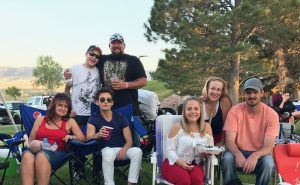 Europe, and he is saving his money from his job in the parks department for the City of Casper. His plan is to take another European vacation hopefully next year after college is out for the summer, or after he finishes college. It is my guess that James will make a number of trips there in the future. James has big plans for his future, and I know that he will be very successful. Today is James’ 21st birthday. Happy birthday James!! Have a great day!! We love you!!
Europe, and he is saving his money from his job in the parks department for the City of Casper. His plan is to take another European vacation hopefully next year after college is out for the summer, or after he finishes college. It is my guess that James will make a number of trips there in the future. James has big plans for his future, and I know that he will be very successful. Today is James’ 21st birthday. Happy birthday James!! Have a great day!! We love you!!
 Many people say they would hate to be born on a holiday, and for the most part I think I agree, but while it isn’t really a “holiday,” Groundhog Day, for my husband’s grandmother, Vina Hein, was a special day. When she was born on February 2, 1909, Groundhog Day in the United States was a mere 22 years old. There are lots of differing views on how it came to be, but apparently, it is pretty much an American tradition. It is thought to be a spinoff, of sorts, of a tradition that started with the early Christians in Europe, and for centuries the custom was to have the clergy bless candles and distribute them to the people. Even then, it marked a milestone in the winter and the weather that day was important. On old song about the day went thus: If Candlemas be fair and bright, Come, Winter, have another flight; If Candlemas brings clouds and
Many people say they would hate to be born on a holiday, and for the most part I think I agree, but while it isn’t really a “holiday,” Groundhog Day, for my husband’s grandmother, Vina Hein, was a special day. When she was born on February 2, 1909, Groundhog Day in the United States was a mere 22 years old. There are lots of differing views on how it came to be, but apparently, it is pretty much an American tradition. It is thought to be a spinoff, of sorts, of a tradition that started with the early Christians in Europe, and for centuries the custom was to have the clergy bless candles and distribute them to the people. Even then, it marked a milestone in the winter and the weather that day was important. On old song about the day went thus: If Candlemas be fair and bright, Come, Winter, have another flight; If Candlemas brings clouds and  rain, Go Winter, and come not again. It all sounds quite familiar doesn’t it? Of course in the Christian religion, it meant something else. It is half way through winter, and it was also thought to be when Mary’s purification day occurred after Jesus was born.
rain, Go Winter, and come not again. It all sounds quite familiar doesn’t it? Of course in the Christian religion, it meant something else. It is half way through winter, and it was also thought to be when Mary’s purification day occurred after Jesus was born.
Nevertheless, leave it to Americans to make their warm weather travel plans based on the machinations of a reticent rodent. Each year, groundhogs around the country…but most notably Punxsutawney Phil of Punxsutawney, Pennsylvania, are paraded out to predict how many more weeks will transpire before spring is on the way. It’s either six more weeks of winter…as was the case with Punxsutawney Phil this year, or an early spring. It all depends upon  whether the groundhog sees his shadow or not. This tradition has been going on since 1887s, despite modest advances in weather prediction since that time…if you think the weatherman knows his business that is.
whether the groundhog sees his shadow or not. This tradition has been going on since 1887s, despite modest advances in weather prediction since that time…if you think the weatherman knows his business that is.
So, while it was not a major holiday, Grandma Hein’s birthday always had an added little bit of sparkle. If her wish came true, the groundhog would predict an early spring, because after all, who isn’t ready for the beautiful flowers of spring in the dead of winter. Today would have been Grandma Hein’s 109th birthday if she were still here. Grandma, I know that where you are, the Spring flowers are always blooming. Happy birthday in Heaven Grandma. We love and miss you very much.
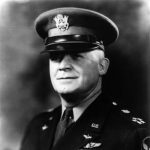 Airplanes are able to do so much more and travel so much further these days than they were in World War II. Back then, planes had to be based in nations closer to the fighting, because bomb runs could not be done from US shores…too much distance. Nevertheless, it wasn’t because no one had considered such a possibility. On September 28, 1942, General Henry “Hap” Arnold ordered the highest priority be given to the development of two exceptional aircraft. They were the B-35 Flying Wing and the B-36 Peacemaker, and they were intended for bombing runs from bases in the United States to targets in Europe. It could have potentially changed the way the war was fought…had everything worked out as planned.
Airplanes are able to do so much more and travel so much further these days than they were in World War II. Back then, planes had to be based in nations closer to the fighting, because bomb runs could not be done from US shores…too much distance. Nevertheless, it wasn’t because no one had considered such a possibility. On September 28, 1942, General Henry “Hap” Arnold ordered the highest priority be given to the development of two exceptional aircraft. They were the B-35 Flying Wing and the B-36 Peacemaker, and they were intended for bombing runs from bases in the United States to targets in Europe. It could have potentially changed the way the war was fought…had everything worked out as planned.
General Arnold was a man of distinction from the beginning of his career. Not only was he one of the first pilots in the US Signal Corps, but he was taught to fly by none other than one of the Wright brothers. During World War I, Arnold was director of aviation training for the Army. Between World War I and World War II, he was a proponent of the controversial military philosophy that emphasized strategic bombing, eliminating the need for the use of ground forces altogether. It was a noble idea, and could have potentially saved many lives, although I don’t know how feasible it really is. I think there are times when ground forces are the only way to go, but I have never fought in a war, so I could be wrong on that thought.
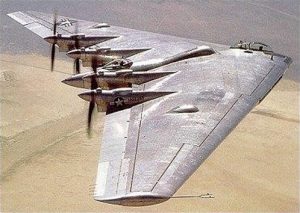
When the United States entered into World War II, the Army Air Forces had become an increasingly distinct military service. General Arnold became its first chief. Along with this honor came the opportunity of a seat with the Joint Chiefs of Staff. Initially this was intended to boost his status to that of his counterpart in Britain, but it also increased the stature and independence of the Army Air Forces. General Arnold was able to form alliances with British RAF allies who also favored the use of strategic bombing in lieu of ground-force operations.
In 1942, Arnold gave the highest priority to the development of two extra long-distance transatlantic planes that would prove most useful to his strategic bombing game plan, the B-35 Flying Wing and the B-36 Peacemaker transatlantic bombers. The B-35 had been first proposed in early 1941, intended for use in defending an invaded Britain. But the tailless design was so radical that it was viewed as…maybe not safe, so the plane was put on the back burner. When I look at the plane, I can see how it might look unsafe, and really not flight worthy.
The plans for the B-35 were finally revived because of advantages the plane afforded over the B-36 bombing range in relation to gross weight, for example. Fifteen B-35 planes were ordered for construction, but the first did not take flight until 1946, after World War II had ended. Designs for the B-36 were also developed early in 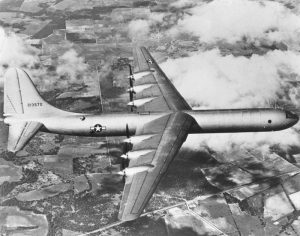 1941, on the assumption that the United States would inevitably be drawn into the war and it would need a bomber that could reach Europe from bases in America. It was to be a massive plane…162 feet long with a 230 foot wingspan. But its construction lagged, and it was not completed until after the war ended either. Although Hap’s “high priority” could not cut through the military bureaucracy of his time, 1947 would see the Nation Defense Act establish an autonomous Air Force…a dream for which he had worked. The B-35 Flying Wing would become the prototype for the B-2 Stealth bomber built in 1989. And the B-36 was used extensively by US Strategic Air Command until 1959, but the B-36 Peacemaker never dropped a bomb.
1941, on the assumption that the United States would inevitably be drawn into the war and it would need a bomber that could reach Europe from bases in America. It was to be a massive plane…162 feet long with a 230 foot wingspan. But its construction lagged, and it was not completed until after the war ended either. Although Hap’s “high priority” could not cut through the military bureaucracy of his time, 1947 would see the Nation Defense Act establish an autonomous Air Force…a dream for which he had worked. The B-35 Flying Wing would become the prototype for the B-2 Stealth bomber built in 1989. And the B-36 was used extensively by US Strategic Air Command until 1959, but the B-36 Peacemaker never dropped a bomb.

 My grandnephew, James Renville is a quiet sort of guy, but let him decide that he needs to tease his dad or his step-dad, and he’s anything but quiet. He not only loves to tease them, but he loves to video the whole process. I’m sure he has two reasons for the video…re-living the moment, and re-torturing the victims. James isn’t being mean, he is just enjoying the moment…and you have to admit that once you have teased someone you love, you have to laugh about the moment for the rest of the day. James is also a great friend to his cousins, many of whom are much younger. He plays with them and teases them as well, and they all love it, and have a great time. That’s the funny thing about little kids…they love to be teased by their older cousins and such, because they know that it’s all in good fun, and they always love the attention.
My grandnephew, James Renville is a quiet sort of guy, but let him decide that he needs to tease his dad or his step-dad, and he’s anything but quiet. He not only loves to tease them, but he loves to video the whole process. I’m sure he has two reasons for the video…re-living the moment, and re-torturing the victims. James isn’t being mean, he is just enjoying the moment…and you have to admit that once you have teased someone you love, you have to laugh about the moment for the rest of the day. James is also a great friend to his cousins, many of whom are much younger. He plays with them and teases them as well, and they all love it, and have a great time. That’s the funny thing about little kids…they love to be teased by their older cousins and such, because they know that it’s all in good fun, and they always love the attention.
James enjoys lots of fun activities with his parents. He loves to travel and they have gone to many awesome places. It has been educational, enlightening, and very fun for James. I’m sure that is why he loves to travel…especially in Europe. James as taken a couple of European trips already, and had a great time on both trips. James reminds me quite a bit of my dad, his great grandpa, Allen Spencer, in that way. My dad loved to travel and loved showing his family this great country. My dad, like James also did some travel abroad, but his travel was during World War II, so I’m sure that many things were different then.
James is in college now, attending Casper College here in Casper. He isn’t sure what field he wants to go into yet, and that’s ok. He is going to get all of the required subjects out of the way, and then he can fully focus on 
 the career of his choosing. James is also a huge fan of and awesome participant in the sport of inline rollerblading. When he puts on his rollerblades, he is in his element. He loves all things rollerblades. James spends quite a bit of time watching YouTube videos of rollerblade tricks and crashes to learn new tricks…and maybe to avoid crashes. He enjoys perfecting his moves, and learning new ones from the videos he watches. His mom, Toni Chase, says he is amazing at rollerblading. Some day I will have to see him for myself. Today is James’ birthday. Happy birthday James!! Have a great day!! We love you!!
the career of his choosing. James is also a huge fan of and awesome participant in the sport of inline rollerblading. When he puts on his rollerblades, he is in his element. He loves all things rollerblades. James spends quite a bit of time watching YouTube videos of rollerblade tricks and crashes to learn new tricks…and maybe to avoid crashes. He enjoys perfecting his moves, and learning new ones from the videos he watches. His mom, Toni Chase, says he is amazing at rollerblading. Some day I will have to see him for myself. Today is James’ birthday. Happy birthday James!! Have a great day!! We love you!!
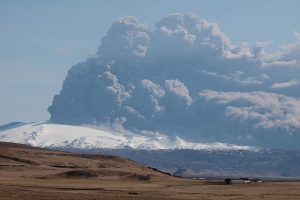 When a volcano erupts, we think of lava and billowing clouds of ash. Those things do happen, but what we don’t think about is what can happen to planes, because of the ash. I suppose that is because we think of that eruption as being a very localized thing. In reality, it isn’t, because the jet stream moves the air around our world, and the ash goes with it. Volcanic ash and airplane engines are not a good mix. Volcanic ash consists of small tephra, which are bits of pulverized rock and glass less than 2 millimeters in diameter created by volcanic eruptions. As the ash enters the atmosphere, it is carried away from the volcano by winds. The ash with the smallest size can remain in the atmosphere for a considerable period of time. The ash cloud can be dangerous to aviation if it reaches the heights of aircraft flight paths.
When a volcano erupts, we think of lava and billowing clouds of ash. Those things do happen, but what we don’t think about is what can happen to planes, because of the ash. I suppose that is because we think of that eruption as being a very localized thing. In reality, it isn’t, because the jet stream moves the air around our world, and the ash goes with it. Volcanic ash and airplane engines are not a good mix. Volcanic ash consists of small tephra, which are bits of pulverized rock and glass less than 2 millimeters in diameter created by volcanic eruptions. As the ash enters the atmosphere, it is carried away from the volcano by winds. The ash with the smallest size can remain in the atmosphere for a considerable period of time. The ash cloud can be dangerous to aviation if it reaches the heights of aircraft flight paths.
Part of the problem is that pilots can’t see ash clouds at night, and ash particles are too small to return an echo to on-board weather radars on commercial airliners. Even when they are flying in daylight, pilots may interpret a visible ash cloud as a normal cloud of water vapor and not a danger…especially if the ash has travelled far from the eruption site. Volcanic ash has a melting point of approximately 2,010° F, which is below the operating temperature of modern commercial jet engines, about 2,550° F. Volcanic ash can damage gas turbines in a number of ways. These can be categorized into those that pose an immediate hazard to the engines and those that present a maintenance problem. As was the case with KLM Flight 867, bound for Anchorage, Alaska, when all four engines flamed out after the aircraft inadvertently entered a cloud of ash blown from erupting Redoubt Volcano, 150 miles away. The volcano had begun erupting 10 hours earlier on that morning of December 15, 1989. Only after the crippled jet had dropped from an altitude of 27,900 feet to 13,300 feet…a fall of more than 2 miles…was the crew able to restart all engines and land the plane safely at Anchorage. The plane required $80 million in repairs, including the replacement of all four damaged engines.
 The 2010 eruptions of Eyjafjallajökull in Iceland, were relatively small for volcanic eruptions. Nevertheless, they caused enormous disruption to air travel across western and northern Europe over the next six days. Additional localized disruption occurred into May 2010. The eruption was declared officially over in October 2010. About 20 countries closed their airspace to commercial jet traffic and it affected about 10 million travelers. This was the highest level of air travel disruption since World War II. It’s strange for us to think that so much can happen to a jet engine is volcanic ash is introduced into it, but that is definitely the case, and if air planes travel in the area of certain types of volcanic ash, planes can be lost. The only prudent thing to do is stop travel in the area…no matter how inconvenient it is to travelers.
The 2010 eruptions of Eyjafjallajökull in Iceland, were relatively small for volcanic eruptions. Nevertheless, they caused enormous disruption to air travel across western and northern Europe over the next six days. Additional localized disruption occurred into May 2010. The eruption was declared officially over in October 2010. About 20 countries closed their airspace to commercial jet traffic and it affected about 10 million travelers. This was the highest level of air travel disruption since World War II. It’s strange for us to think that so much can happen to a jet engine is volcanic ash is introduced into it, but that is definitely the case, and if air planes travel in the area of certain types of volcanic ash, planes can be lost. The only prudent thing to do is stop travel in the area…no matter how inconvenient it is to travelers.

